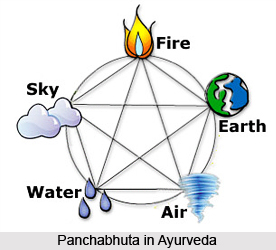 Panchabhuta in Ayurveda are said to be in balance and the same thing applies to the human beings too. Ayurveda states that the human body is also made up of the 5 elements that are: Earth, Water, Fire, Air and Space. When these things occur within the body, the body suffers from sickness and diseases.
Panchabhuta in Ayurveda are said to be in balance and the same thing applies to the human beings too. Ayurveda states that the human body is also made up of the 5 elements that are: Earth, Water, Fire, Air and Space. When these things occur within the body, the body suffers from sickness and diseases.
The 5 elements are seen in the body in the form of 3 body types known as "Doshas". The doshas exist in all matter and are composed of different combinations of the 5 elements. They are: Vata, Pitta and Kapha. Their influence affects all mechanisms of the body.
According to Ayurveda, everything in life is composed of the Panchabhutas - Akash (Space), Vayu (Air), Jal (Water), Agni (Fire) and Prithvi (Earth). The Panchabhutas are described below;
Earth: Earth represents the solid state of matter and it indicates stability, permanence, and rigidity. The body parts such as bones, teeth and tissues are considered as earth element. Earth is considered a stable substance.
Water: Water represents the liquid state of matter and it indicates changes or unstable. Water is vital for the survival of all living things. The blood, lymph and other fluids are considered as water element. Large part of the human body is made up of water element. Water elements bring energy, carry away wastes, regulate body temperature and carry nutrients and oxygen.
Fire: Fire represents the form without substance and it has the power to transfer the state of any substance, for instance solids into liquids, to gas and back again. Fire element is an invisible energy that binds atoms together, converts food to energy or fat (stored energy), and creates nervous reaction, feelings, and even thought processes.
Air: Air represents the gaseous form and it indicates mobility and dynamic. Within the body, air (oxygen) is vital for all energy transfer reactions. Air is a key element needed for fire to burn.
Space: Space represents the space in which everything happens. This is the field which is simultaneously the source of all matter and the space it exists. The main characteristic of space is sound and it represents the entire spectrum of vibration.
Panchabhutas in Ayurveda therefore serve as the foundation of all diagnosis and treatment modalities in Ayurveda and has served as a most valuable theory for physicians to detect and treat illness of the body and mind successfully.




















